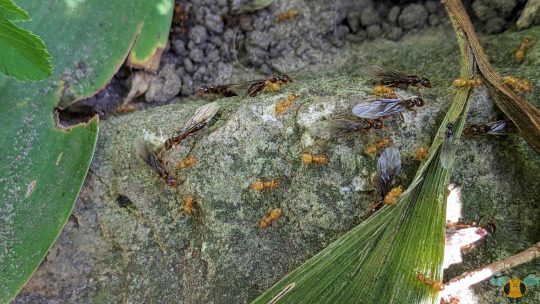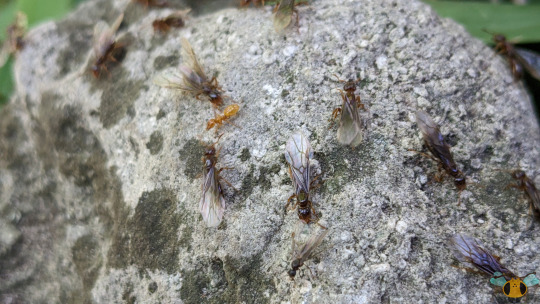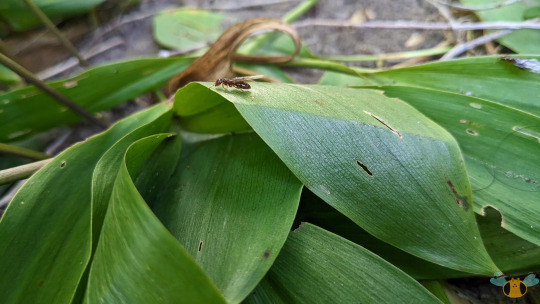#lasius claviger
Text










Smaller Yellow Ant - Lasius claviger
Before covering the nuptial flights of this subterranean dwelling insect colony, I have some announcements for the blog. Firstly, the blog's text highlight color has finally been fixed. Text should now be highlighted in orange; give it a try. Secondly, I'm finally taking the step to enter YouTube, start a channel* and share these insects there. I hope you'll join me in this new venture. There will be an additional post covering this, but in the meantime you may refer to this blog link for additional information. Finally, yesterday was this blog’s 5 Year Anniversary! I feel quite sheepish in hindsight that the highlight color took 5 years to fix, but I'm not much of a programming whiz. My focus is, and always will be on the insects I find and to share the photography and videography I make with all of you, my dearest readers. Wow! 5 years. What a journey it has been. I'm incredibly grateful for all my followers (both old and new), the readers who frequent my blog, and the fellow bug-hunters on this website that have inspired me! I sincerely thank you! Furthermore, none of this would've happened or continued without the contributions, encouragement and support from my closest friends and my family. To them, I give all the thanks in the world and my deepest appreciation! And now, let's talk about Ants, nuptial flights and usurping queens! While tidying the yard due to the weather beginning to change , I was greeted by a flurry of winged alates emerging from the ground near a collection of buried backyard stones.
These images don't do the sheer volume of winged Ants justice, but there must've been hundreds emerging from their nest! It's a mad rush to spread out and secure a colony before the cold sets in (more on that to come). The backyard plays host to many Ant species, but this was the first time I've seen these before. False Honey Ants came to mind first since they don't mind the cold, but with no size disparity (and timing of emergence) it was clear that these alates were something else. The lemony-yellow color of the wingless worker Ants provided a clue, and I was directed immediately to the genus Lasius, more commonly known as Lemon Ants or Citronella Ants. They are named for more than just their colorful body; they can defend themselves and rouse a colony defense whose fragrance is similar to the scent of lemon. Though it may smell pleasant to us, I'm not sure if these Ants would taste very lemony. With the risks from bites, formic acid and soil sanitation conditions, I can't recommend you eat them; observing them should be enough. While I observed them, the scent was in action, and while the alates where docile and airborne, the workers are alert and I did get nipped a few times while poking near their colony's entrances. Compared to the worker Ants, the winged alates are much larger and appear to have more defined sclerotization, but they didn't seem inclined to bite me.
Naturally the winged Ants are stored up with fat reserves to prepare the young queens for initial building of a colony and the first wave of offspring that will tend the queen. Why so many alates though? Well, the answer is one even I didn't expect: this specie of Citronella Ant reportedly usurps (parasitizes technically speaking) the colonies of of other Citronella Ants that have already established nests slightly earlier in the year! Since they don't make their own colonies and competition is fierce, many individuals are born to grant the best opportunity possible to find a colony, infiltrate it, depose the queen inconspicuously and take her place! It is madness, but with winter on the way, it's every Ant queen for herself! However, it is reported that these Ants can forage during the colder months, similar to the False Honey Ant, assuming of course the specie I chose is accurate. I've ultimately settled on L. claviger as the time of emergence lines up (right on the edge of October) within the North American environment and from the sheer number of alates in flight. Distinguishing between species is very technical without an close-up observation of individuals, consideration of range and emergence flight, but identification down to the genus is easy if you smell lemons. If you wish to search for them, check under large stones or in the soil beneath rotting stumps. Since I know they're in the yard now, I'll see if I can share future posts with foraging Ants searching for colony provisions. Yellow coloration should make them easy to spot, but they may stay underground.
Pictures were taken on September 30, 2023 with a Google Pixel 4. Thank you all for an interesting 5 years, and for more years to come!
*Note: The channel was deliberately started so as to coincide with the anniversary of this blog. This makes tracking the anniversaries of both platforms much easier. Now onto the next media publishing step...
#jonny’s insect catalogue#ontario insect#ant#citronella ant#lasius claviger#lasius sp#lemon ant#hymenoptera#toronto#september2023#2023#blog anniversary#milestone#5 year anniversary#happy 5 years#happy five years#nature#entomology#invertebrates#arthropods
3 notes
·
View notes
Text
Painting of the queen ant I found. Lasius claviger



12 notes
·
View notes
Note
A long time ago, when I was a kid at a summer camp, one of the camp guides showed us a particular ant that lived in the area. They said that if you licked its abdomen, it'd taste like lemons. I licked it, and sure enough, that ant's butt tasted like lemons. I can't remember where this camp was or what ant it was, though.
Anyway I'm sending this ask partly because I thought you might find the story interesting and partly because I'm curious if you have any guesses about what ant I may have licked all those years ago.
Lasius in the L. claviger group secrete lemon-secented compounds, which is why their common name is “citronella ants”
140 notes
·
View notes
Text



Starting the new year out right by bugposting
The bugs: common citronella ant (Lasius claviger), Brachyiulus millipede, and dwarf spider (subfamily Erigoninae)
6 notes
·
View notes
Text
lookit this ant nest! that’s a lotta larvae, huh

...oh wait


that ain’t children, that’s livestock.

The relationship between ants and aphids or other sap- feeding insects is pretty widely known, but these ants (probably Lasius claviger) rear their root aphids inside their nest, farming them for both honeydew and meat. The ants are pale yellow because they almost never go aboveground, and considering that they’ve been known to eat the “excess” nymphs of their massive aphid herds, they probably don’t have much reason to leave their nest at all.
Root aphids like these aren’t normally found outside Lasius nests, and unlike freeliving aphids they have a special organ for holding honeydew until it’s ready to be milked by an ant.
I found this scene under a sheet of scrap metal, with the aphids left in loose piles with few or no roots available to drink sap from. I’m guessing that the ants moved them under the sun- warmed metal to heat them up and speed their growth and digestion between meals, a trick many ants practice on their larvae.
3K notes
·
View notes
Photo

In March, while digging a shallow hole in my garden, I disturbed a colony of Smaller Yellow Ants (Lasius claviger). No doubt they had been busy working their way to the surface as the frost was going out. Fossils suggest that ants have been around over 65 million years, with no sign of slowing down. Study the ant and you will soon realize that nature’s imperative will not be repressed.
11 notes
·
View notes
Text
Lasius will Amaze-i-Us

Lasius workers tending a flock of aphids underground. Photo by Alex Wild.
Common Lasius ants tend aphids that live underground feeding on plant roots. They protect the herd of aphids from other ants, and move them to more productive roots if the plant dies back. Sometimes the future queen will pick up an aphid in her mandibles and carry it along on the mating flight, and place it on a good root in the wall of the first nest chamber to start a new herd of aphids.
At this time of year, Lasius have their mating flights. A warm day with some rain in the afternoon to soften the soil, and then a clear sky near sundown would be perfect. The ants will be in the top of the nest, awaiting the exact right moment. Somewhere between about 4:00 pm and 7:00 pm, when the atmosphere is just right, workers dig several passages to the surface, and usually the small and slender male ants emerge first, taking flight quickly. Future queens, much larger than the workers or males, and bearing large wings, emerge next and take flight. All the colonies in the landscape where the weather is appropriate may emerge in a time span as short as five or ten minutes. We found dozens of colonies of two species (below) emerging in an area of our lawn about 20 feet by 40 feet.

Silver wings of many male Lasius neoniger are obvious as they prepare to take flight. Photo by Donna Wenzel.
The many gossamer wings may give the impression of smoke rising from the soil. Swallows, swifts, and other birds will fly in circles snapping up the winged ants. The queens will mate with one or a few males, who die promptly, and then the queens will dig into the moist soil and create a chamber for her new nest, maybe with an aphid she carried along the way to start her new colony.
But the life of Lasius ants is not all pastoral peace and harmony. Two different methods of parasitic attack have evolved where a queen of one species of Lasius will invade the nest of a different species of Lasius to take it over. In one of these methods, the parasitic queen releases citronella, a lemon-like odor that is pleasant to humans but communicates alarm to ants. The workers avoid the invading queen who works her way into the chamber where the host queen is. Quickly, the parasitic queen accumulates the odor of the host colony, and the workers will not recognize her as an alien usurper.

Here we see several large, winged Lasius claviger queens among many small workers, preparing to fly. These queens will parasitize mature colonies of other species, such as L. neoniger above. A few small, dark males are visible top, center. Photo by Donna Wenzel.
A different method used by some species is that the queen is very hairy or armored, and simply fights her way into the host nest. There, the invader may kill the host queen. By either method, the parasitic queen takes over the host nest, and the workers of the original colony, not knowing any better, spend their lives raising the offspring of the parasitic queen. As the original workers die out, the workers of the parasitic queen replace them until the colony is entirely of the parasitic species.
If you keep a sharp eye out at this time of year, you have a good chance of observing a mating flight of Lasius or another ant species, but you have to be in the right place at exactly the right time!
John Wenzel is the Director at Powdermill Nature Reserve, Carnegie Museum of Natural History’s environmental research center. Museum employees are encouraged to blog about their unique experiences and knowledge gained from working at the museum.
22 notes
·
View notes